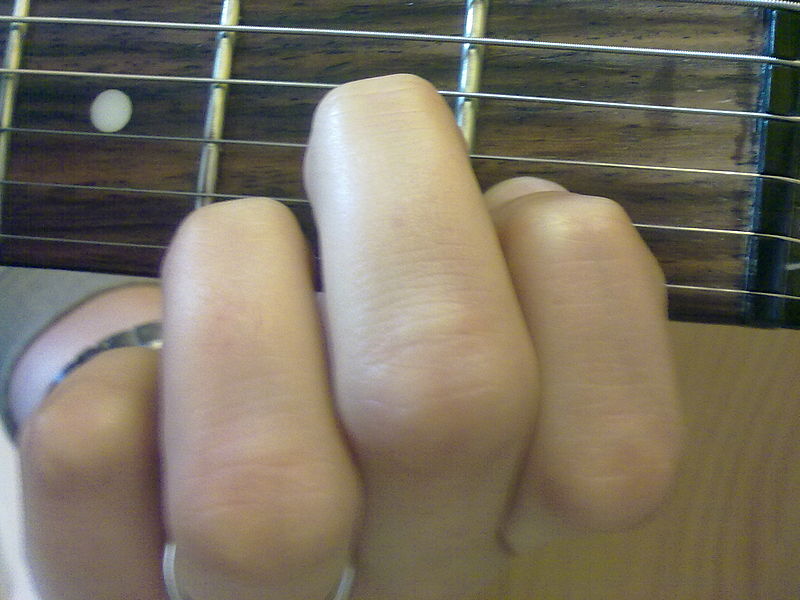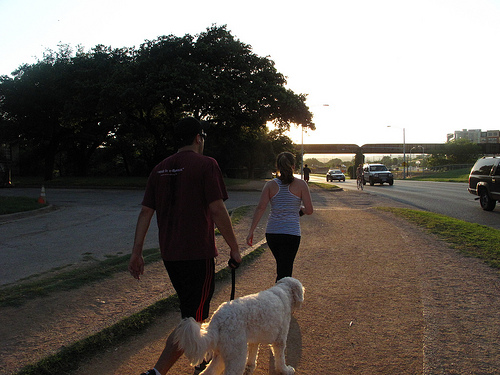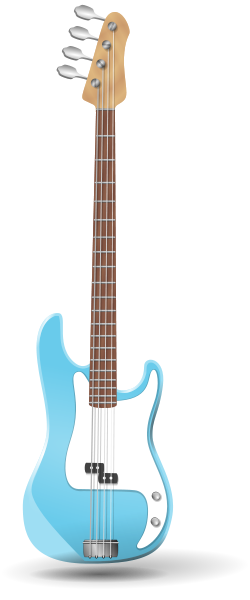
Source: RE7 accordo chitarra D7 guitar chord, Elenaf, Wikimedia
 You now have a strong start to your expository essay, so let’s “run” with it! Read the excerpt below from an article about running. After you finish reading, copy and paste the chart that follows (the same one from the previous section) into your notes. Next, fill in your chart. When you’re finished, check your understanding to compare your chart to a sample one.
You now have a strong start to your expository essay, so let’s “run” with it! Read the excerpt below from an article about running. After you finish reading, copy and paste the chart that follows (the same one from the previous section) into your notes. Next, fill in your chart. When you’re finished, check your understanding to compare your chart to a sample one.
Source: Photowalk Lady Bird Lake Trail, alachia, Flickr
Is It Better to Walk or Run?
By Gretchen Reynolds
. . . And in perhaps the most comforting of the new studies, published last month in Arteriosclerosis, Thrombosis and Vascular Biology and again using numbers from the “versatile Runners and Walkers Health Study,” runners had far less risk of high blood pressure, unhealthy cholesterol profiles, diabetes and heart disease than their sedentary peers. But the walkers were doing even better. Runners, for instance, reduced their risk of heart disease by about 4.5 percent if they ran an hour a day. Walkers who expended the same amount of energy per day reduced their risk of heart disease by more than 9 percent.

Source: Photowalk Lady Bird Lake Trail, alachia, Flickr
Of course, few walkers match the energy expenditure of runners. “It’s fair to say that, if you plan to expend the same energy walking as running, you have to walk about one and a half times as far and that it takes about twice as long,” said Paul T. Williams, a staff scientist at Lawrence Berkeley National Laboratory and the lead author of all of the studies involving the surveys of runners and walkers.
On the other hand, people who begin walking are often more unhealthy than those who start running, and so their health benefits from the exercise can be commensurately greater.
“It bears repeating that either walking or running is healthier than not doing either,” Dr. Williams said, whatever your health goals.
| Paragraph | Key words and phrases | Content (essential information) | Author’s style or craft |
|---|---|---|---|
| 1. | |||
| Paragraph | Key Words and phrases | Content (essential information) | Author’s style or craft |
|---|---|---|---|
| 1. | most comforting of the new studies; walkers were doing even better; runners reduced their risk of heart disease by about 4.5 percent; walkers reduced their risk of heart disease by more than 9 percent | A new study indicates that both runners and walkers reduced the risk of heart disease, but walkers reduced their risk by twice as much. | The author uses specific data from studies and describes various health benefits. The use of statistics is very convincing. |
| 2. | few walkers match the energy expenditure of runners; you have to walk about one and a half times as far and that it takes about twice as long | Runners expend more energy than walkers, so walkers must walk one and one half times as far and take twice as long. | The author explains that you’ll have to spend more time and effort walking to get the same benefits of running. This makes sense and encourages people to find other options for exercise. |
| 3. | People who begin walking are often more unhealthy than those who start running; health benefits from the exercise can be commensurately greater. | Beginning walkers, as opposed to beginning runners, are often unhealthy so their health gains are greater. | The health gains that the author speaks of makes me want to encourage my friends who need to improve their health to walk. |
| 4. | walking or running is healthier than not doing either; whatever your health goals | Regardless of your health goals, both walking and running are better than doing nothing. | The author provides great reasons to choose running or walking in order to be healthy. |

Source: Bass Guitar, AJ,
Wikimedia
You now have enough information to create a plan for your own expository essay. This step is a bit like writing music for the bass guitar once you have worked out the lead guitar part. Similarly, you pull out the best information from your various sources to use in your final expository essay. Look back at the previous two charts you filled in about the articles you read. To accurately synthesize this information, you will need to compare your findings.
What might be useful for you to ask when you compare your sources? When you place the two sources side by side, you are looking for common points as well as points that distinguish the author’s views. To help you make a comparison, complete a comparison chart. Take a look at the one below. Note the three questions in the first column. Answering the three questions for each article will help synthesize the information. First, review the questions and then drag and drop information from the two articles to the correct places in the chart. Refer to the article in the graphic organizer from the previous section and the article above if needed.


Source: The Color Run Cheer, Bill Dickinson, Flickr
Great job! You are synthesizing information from a variety of sources. Now, you are ready to proceed to the next step, which is putting all the points together into a coherent, consistent essay.